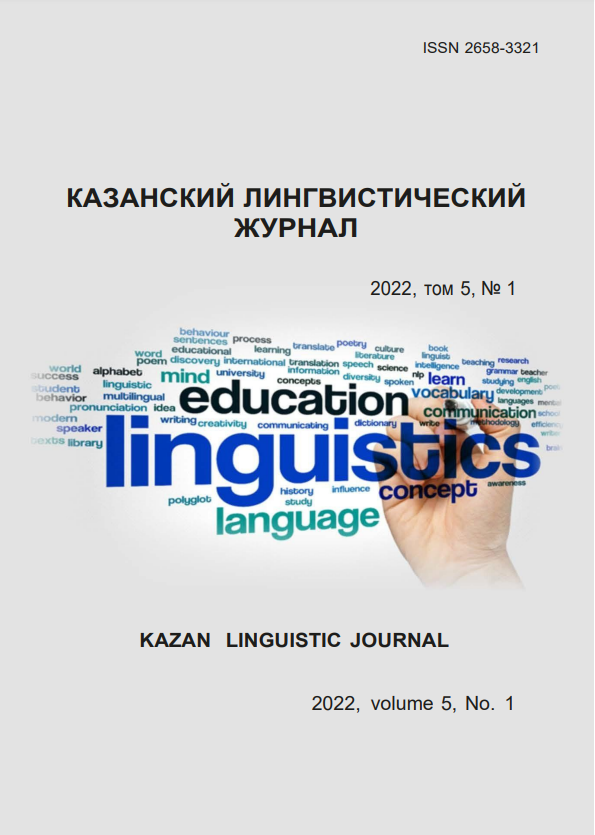Language teaching by linguodidactic methods through removing the language barrier
https://doi.org/10.26907/2658-3321.2022.5.1.121-139
Keywords:
pedagogical science, psychological aspect, student, teaching, communicative method, contextual approach, future specialistAbstract
The presence of a large number of teaching methods does not always allow graduates of both linguistic and non-linguistic universities, even those with good language knowledge, to speak the languages they are studying relatively freely, especially in situations of spontaneous speech. The reason, in our opinion, is the fear of making a speech in different situations when solving a variety of communicative tasks. The phenomenon under consideration confirms the presence of the so-called language barrier that prevents effective foreign language communication between representatives of multilingual specialists. The purpose of the study was to try to introduce into the educational process such linguodidactic methods that could help to remove the language barrier as a psychological factor. The problem was studied by such domestic scientists as L.S. Vygotsky, I.A. Winter, A.N. Leontiev, N.D. Galskova, E.I. Passov, H.F. Makayev and others. A great contribution to the solution of the problem was made by the works of such foreign scientists as B. White, J. Bruner, W. Penfield, R. Roberts, T. Eliot, R. Clement, P. McIntyre, K. Noels and others. The study was based on a combination of the communicative method and the contextual approach by providing language learners with comprehensive support, in particular psychological, in thought formation, speech formation and speech production. All teaching methods and techniques were supported by the surprise approach, which determines the factor of spontaneous speech. The study was conducted on the basis of the implementation of all four types of speech activity. The results showed that a comfortable atmosphere, the role of a teacher in motivating students to learn a language by supporting their desire to achieve success, taking into account the personal, professional and linguistic qualities of students through the use of effective linguodidactic techniques, supported by psychological aspects, contribute to the practical implementation of the research goal and making a certain contribution to the theory of pedagogical science.
References
Bruner J.S. Education process. Cambridge, MA: Harvard University Press; 1960.
Llah A., Pilar M. Teaching language through literature: Wasteland in the ESL classroom. Odyssey. Journal of English Studies; 2017.
Galskova N.D., Gez N.I. Theory of teaching foreign languages. Linguodidactics and teaching methods. Student allowance Izdatel'skij сentr «Akademiya»; 2006. p.19-20. (In Russ.)
Grabe W, Stoller F. Reading and vocabulary development in a second language: a case study. Cody J., Hakina T. Second language vocabulary acquisition. Cambridge: Cambridge Univer-sity Press; 1997. p. 98-122.
Lazar G. Teaching literature and language. The Routledge Handbook of Language and Cre-ativity Routledge; 2015.
Makayev Kh.F., Makayeva G.Z. Listening-Reacting Ability as One of Vital Activities for Training Spontaneous Communication Skills. EDULEARN19: 11TH International Conference on Education and New Learning Technologies, 1957 – 1962; 2019.
Flerov O.V. Correction of errors in the oral speech of students in the process of communica-tive teaching of foreign languages. Vysshee obrazovanie segodnya. 2012;(7):63-65. (In Russ.)
Zimnyaya I.A. Pedagogical psychology. Textbook for high schools. 2nd ed., corrected, re-vised. M.; 1999. (In Russ.)
Big explanatory psychological dictionary. T.1. M: Veche Ast; 2000. (In Russ.)
Masgoret A.‐M., Gardner R. Attitudes, Motivation, and Second Language Learning: A Me-ta‐Analysis of Studies Conducted by Gardner and Associates. Language Learning 53(S1); 2003. p.123-163.
Arnold J. Self-concept and the affective realm in language learning, self-esteem and foreign language learning. Cambridge: Cambridge Scholars Press; 2007. (In Russ.)
Epanchintsev G.A., Kozlovskaya T.N. Relationship between success motivation and person-ality rigidity. Vestnik Orenburgskogo gosudarstvennogo universiteta. 2020;227(4):95-104. (In Russ.)
URL: http://naukarus.com/yazykovoy-barier-prichiny-vozniknoveniya-i-puti-preodoleniya. [accessed 03.11.2021]. (In Russ.)
Makayev Kh.F., Makayeva G.Z., Yakhin M.A. Teaching Speaking as the Process of Leading Students from Pure Memorization to Meaningful Communication. INTED2017: 11th International Technology, Education and Development Conference; 2017. p. 4795-4799. DOI: 10.21125/INTED.2017.1117
Bruner J.S. Opening act. Harvard Educational Review. 1961;(31):21-32.
Makayev Kh.F., Makayeva G.Z., Yakhin M.A., Gulkanyan M.K. The Formation of Stu-dents' Communicative Competence by Considering their Personality Features. 9th International Conference on Education and New Learning Technologies (EDULEARN17); 2017. p.5166-5171.
Makaev H.F. Professionally-oriented foreign language training of students as a factor in increasing the motivation of professional and career growth: Monograph. Ufa: Izd-vo UGPTU; 2007. (In Russ.)
Burt M., Dulai H., Finocchiaro M. Perspectives on English as a second language. New York: Regent's Publishing Company; 1977. (In Russ.)
Makaev H.F. Language environment as the main condition for the effectiveness of teaching a foreign language. Alma mater. Vestnik vysshego obrazovaniya. 2014;(7):92-95. (In Russ.)






